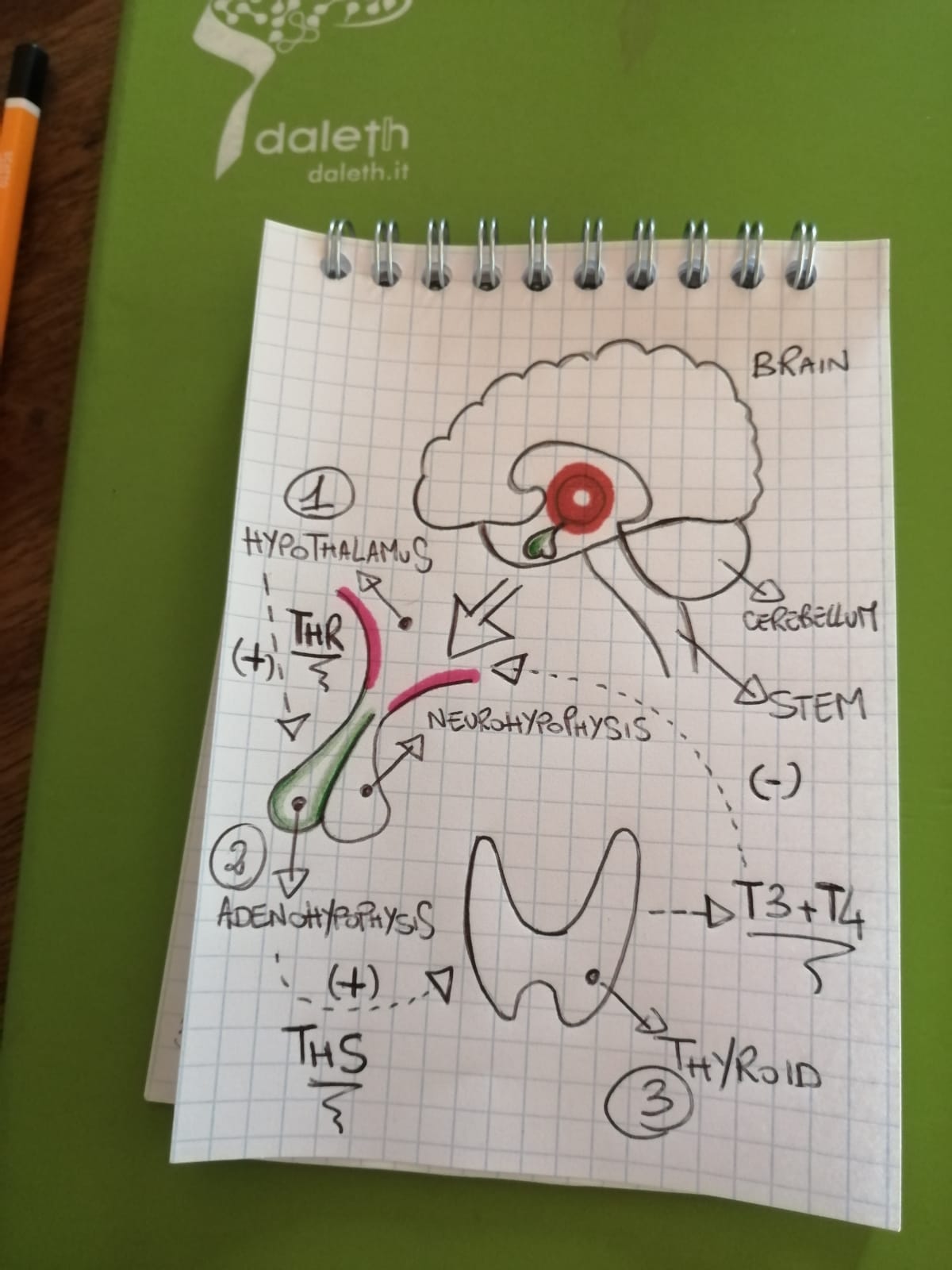Thyroid regulates time and speed
This small butterfly is essential whenever I have to grab something quickly (Italian translation at the end)
AXES
In this article I will do an experiment that I have never tried before. I will attempt to explain the functioning of two glands located in different parts of the body, but at the same time closely interconnected to each other. Mind you. All organs are interconnected with each other, but the glands I am going to write about have a kind of special "contract." We might call it a "contract of exclusivity," in that they are in continuous communication through programs that in biology are called "axes." The two organs are the thyroid gland and the pituitary gland.
The former is located at the neck and is a gland having the shape of a butterfly, in that it is divided into two lobes that join together in an isthmus. The pituitary gland is an organ that in turn is divided into two parts: adenohypophysis and neurohypophysis. The one I will consider in this article will be the former, as it is composed of cells of endodermal origin. The function of these two glands is the same: to secrete hormones. The contract I mentioned a few lines ago requires the pituitary gland to produce a specific hormone that regulates the production of further hormones by the thyroid gland. The hormone produced by the adenohypophysis is known by the acronym TSH, but it is also called "thyrotropin" or "thyrotropic hormone."
The suffix "-trope" means "to turn," "to go toward," and this gives a better understanding of the expression "target organ" used in biology.
The hormone TSH, in this case "turns" or "goes toward" the target organ "thyroid" to regulate its production of hormones, in this case T4 and T3, abbreviations that stand for "thyroxine" and "triiodothyronine," respectively. Mind you, these are the hormones whose production is regulated by the adenohypophysis, however, the thyroid gland also produces other hormones, such as "calcitonin" and "thyroglobulin" that are not dependent on it. Calcitonin serves to regulate the deposition of calcium in bone and plasma, while thyroglobulin is a hormone that serves to ensure the regular processes of thyroid hormone production through a process called "ionidation." The numbering of the two thyroid hormones indicates just that:
T3 Thryiodothyronine: 3 iodine atoms
T4 Thyroxine: 4 iodine atoms
The purpose of these hormones is to increase the rate of metabolism in most tissues of the body, which is why the thyroid appears to be among the most vascularized glands. The thyroid is also important for the processes of cell growth and multiplication.
Also the adenohypophysis actually produces not only TSH hormone whose purpose is to "modulate" the secretion of thyroid hormones, as we have just seen. The hormones produced are as follows:
GH or somatropin (growth hormone)
PRL or prolactin (lactation hormone)
ACTH or adenocotropic hormone
FSH and LH or gonadotropins
The last two categories indicated (ACTH and FSH/LH) are part of two other axes, the adrenal glandular axis and the gonadal axis, respectively. Regarding the increase in function of this gland (adenohypophysis), it is quite clear to understand the conflicts related to it when discussing prolactin and somatropin. In the former case there will be an increase in the function of the gland to produce more prolactin if the emotional resentment has to do with children. For example, there could be an increase in function in the case where a mother feels that she cannot feed her children properly. The difference between this resentment and that of the liver (lack of nutrition) is very subtle. Probably in this case we are in a dimension much more related to pregnancy and the visceral relationship between mother and child. As always, investigation remains the most effective diagnostic tool. Regarding GH hormone, the emotional resentment is that of "feeling too small to be able to achieve something or a goal." In the active phase we will have increased function of the gland to secrete more growth hormone, and in the repair phase the usual procedure of destruction of the adenoma by caseous necrosis as a result of the action of microorganisms will follow. In such cases, there may be cases of “acromegaly”, which is abnormal growth of the extremities in adults. This phenomenon can be observed very well in some sportsmen who participate in "height sports" such as basketball or volleyball. Increased secretion of GH hormone can lead to very rapid increases in height and massive developments in overall physique.
As for the hormones participating in what are called "axes" (TSH, ACTH and FSH/LH), the increase in function is closely related to the emotional feeling of the target organ. See diagram below:
TSH - Hypophysis/Thyroid Axis
ACTH - Hypophysis/Adrenal axis
FSH/LH - Hypophysis/Nadrenal Axis
SPEED
In order not to cause confusion, I deliberately omitted another key element of the axis. In fact, the pituitary gland is not the primary regulator of this process. In fact, the production of these hormones depends on another portion of the brain directly connected to the pituitary gland: the “hypothalamus”. In the case we are temporarily interested in, namely the pituitary-thyroid axis, the production of the hormone TSH by the pituitary gland is regulated in turn by the hormone TRH, produced precisely by the hypothalamus.
To conclude this brief digression, we can therefore say that the pituitary gland is in turn the target organ of the hypothalamus, which, based on the amount of T3 and T4 hormones present in the bloodstream, "orders" the pituitary gland how much TSH to produce, resulting in a perfect and functional cycle that is intended to manage the body's regular metabolic functions. We have seen that the thyroid secretes the hormones T3 and T4 to regulate the body's metabolic rate. Emotional resentment is found in the latter expression: speed. The brain activates the thyroid when it wants to put me in a position to grasp (or get rid of) a morsel celerely. It is an activation that is meant to give me the booster to be able to make a sprint that I would not otherwise be able to make.
As always, I try to help myself with a concrete example. There are rumors in the office about the acquisition of a new client. This is a very important one, whose involvement with the product we sell could bring a lot of prestige to the company and the consultant who will be following them. A colleague informs me that the managers have already identified the person to whom the project will be assigned. I want to take charge of it because I want to accelerate my professional growth and consequently I have to move to make sure that the project is given to me to be managed. Accordingly, I begin to "step up" by expressing keen interest in the likely future project, paying particular attention to the fact that any colleagues might "take" the much-coveted client away from me. In this case, the activation would take place in the right lobe of the thyroid as it is a morsel I have to assimilate. On the contrary, should I find myself in the situation of having to get rid of a client as inconvenient, obnoxious, or too demanding, I will mobilize so that I can get rid of it as quickly as possible, even working through the night to finish the current project. In this case the activation would take place in the left lobe as it is a morsel that I want to let go of quickly.
The thyroid is also considered in the five laws environment as the organ of time. Speed and time are two related concepts. I can also activate the thyroid with the following emotional conflicts: "I don't have enough time for me" or even "I have to hurry up and finish everything, otherwise I can't carve out space to do my own thing."
Very often the thyroid is triggered in women who work a lot and once they clock out they have to pick up their child from grandma's house and at the same time they have to go shopping and prepare food for everyone. I have "romanticized" the example a bit, but I hope I have expressed the concept well. It is very common in women who have to do everything very quickly and in a short time.
HYPO VS HYPER
Let us now see what biological activation of the thyroid gland consists of. In the active phase a secretory-quality adenocarcinoma will form (it is also called "compact struma"). In this case we will have so-called "hyperthyroidism," which is an increase in the production of thyroid hormones so that metabolism is accelerated and the individual can act faster. We also speak of Basedow's disease or "uni- or plurinodular toxic goiter, depending on how many adenocarcinomas have formed. In this case, the adenohypophysis is also stimulated in the production of TSH, which is essential and necessary for the production of thyroid hormones. In the solution phase, we can have two distinct phenomena:
"Recurrent Hyperthyroidism”
The prefix "hyper-" means precisely a surplus, in this case an increase in hormone production. We find this at the time when the nodule cystifies in the solution phase. In these cases, we speak of "cold nodules," which continue to be "operational," and therefore the production of thyroid hormones continues to be higher than standard levels even after solution has occurred. The phenomenon of cystification occurs in all endodermal tissues if there has not been sufficient proliferation of mycobacteria and fungi in the active phase of biological activation.
"Hypothyroidism"
Hypothyroidism consists of decreased function of thyroid follicles and is the case when there is a clinical picture of recurrence. The succession of biological activations of the thyroid gland result in continuous neoplastic formation and subsequent destruction of the tumor by caseous necrosis, giving rise to infection, swelling and chronic inflammation, which in the long run can lead to desiccation of the gland or to the phenomenon of mucoviscidosis, i.e., altered and reduced secretory activity, with excessive viscosity and density of the glandular product.
The thyroid is a very complex organ and as we have seen it affects multiple functions of the body. I apologize for the perhaps excessive technicality in the first part of the article, but it behooves us to understand the purpose of the hormones involved. Addressing the pituitary-thyroid axis requires a great deal of time and certainly additional specificity, however at the moment I believe the information covered may be sufficient to begin to structure an idea of what the adenohypophysis and thyroid represent in the context of biological activations.
Speed is an emotional resentment that could involve other tissues as well, and this makes it so that every individual, with the nuances and peculiarities that characterize him or her, can activate the thyroid gland when it is in the condition of being faster.
However, if we take the example of the client to be "grabbed," the above-mentioned individual might activate the tendons. In this case, we are in the mesorecent embryonic leaflet, and the emotional resentment might be as follows, "I'm not snappy enough, I have to move otherwise I can't show how good I am." In this case, the biological processes are different than the one addressed in this article, as we are in a different embryonic leaflet (mesorecent) and a different emotional resentment (devaluation). Another possibility could be to activate the medullary structure of the adrenal glands, which are deputed to produce "catecholamines" such as "dopamine" and "noradrenaline," hormones that are essential for overcoming high-stress situations. Not surprisingly, thyroid and adrenal medulla activity usually work in synchrony, although the functions of the respective hormones are different. The biological sense, however, is certainly very similar, which again confirms the complexity of biological programs.
This is why I strongly emphasize the importance of the investigation. The program, taken in its uniqueness, represents an objective and systematic fact. Investigation to figure out which program it is, on the other hand, is a process that requires flexibility, dedication, passion, love and patience, ingredients that are fundamental to symptom diagnosis.
Stay tuned.
LA TIROIDE REGOLA IL TEMPO E LA VELOCITÀ
In questo articolo farò un esperimento che non ho mai provato prima. Tenterò di spiegare il funzionamento di due ghiandole localizzate in parti diverse del corpo, ma che nel contempo sono strettamente interconnesse l'una all'altra. Intendiamoci. Tutti gli organi sono interconnessi tra di loro, ma le ghiandole di cui mi appresterò a scrivere hanno una sorta di “contratto” speciale. Potremmo chiamarlo “contratto di esclusiva”, in quanto sono in continua comunicazione tramite dei programmi che in biologia vengono definiti “assi”. I due organi sono la tiroide e l'ipofisi. La prima si trova in corrispondenza del collo ed è una ghiandola avente la forma di una farfalla, in quanto divisa in due lobi che si congiungono tra loro in un istmo. L'ipofisi è un organo che a sua volta è diviso in due parti: adenoipofisi e neuroipofisi. Quella che prenderò in considerazione in questo articolo sarà la prima, in quanto è composta da cellule di origine endodermica. La funzione di queste due ghiandole è la medesima: secernere ormoni. Il contratto a cui ho fatto cenno qualche riga fa prevede che l'ipofisi produca un ormone specifico che regoli la produzione di ulteriori ormoni da parte della tiroide. L'ormone prodotto dall'adenoipofisi è conosciuto con l'acronimo TSH, ma viene anche chiamato “tirotropina” oppure “ormone tireotropo”. Il suffisso “-tropo” significa “volgere”, “andare verso” e questo fa capire meglio l'espressione “organo bersaglio” utilizzata in biologia. L'ormone TSH, in questo caso “volge” o “va verso” l'organo bersaglio “tiroide” per regolarne la produzione di ormoni, nella fattispecie T4 e T3, abbreviazioni che stanno ad indicare rispettivamente “tiroxina” e “triiodiotironina”. Attenzione, questi sono gli ormoni la cui produzione è regolata dall'adenoipofisi, tuttavia la tiroide produce anche altri ormoni, come la “calcitonina” e la “tireoglobulina” che non sono dipendenti da essa. La calcitonina serve per regolare il deposito del calcio nelle ossa e nel plasma, mentre la tireoglobulina è un ormone che serve per garantire i regolari processi di produzione degli ormoni tiroidei, tramite un processo che viene definito “ionidazione”. La numerazione dei due ormoni tiroidei indica proprio questo:
T3 Triiodiotironina: 3 atomi di iodio
T4 Tiroxina: 4 atomi di iodio
Lo scopo di questi ormoni è di aumentare la velocità del metabolismo nella maggior parte dei tessuti del corpo, motivo per il quale la tiroide risulta essere tra le ghiandole più vascolarizzate. La tiroide è anche importante per i processi di crescita e moltiplicazione cellulare.
Anche l'adenoipofisi in realtà non produce solamente l'ormone TSH il cui scopo è quello di “modulare” la secrezione di ormoni tiroidei, come abbiamo appena visto. Gli ormoni prodotti sono i seguenti:
GH o somatropina (ormone della crescita)
PRL o prolattina (ormone della lattazione)
ACTH o adenocotropo
FSH e LH o gonadotropine.
Le ultime due categorie indicate (ACTH e FSH/LH) fanno parte di altri due assi, rispettivamente quello della ghiandolare del surrene e quello della gonadi. Per quanto riguarda l'aumento di funzione di questa ghiandola, risulta abbastanza chiaro comprendere i conflitti ad essa legati quando si parla della prolattina e della somatropina. Nel primo caso si avrà un aumento di funzione della ghiandola per produrre più prolattina, qualora il risentito emotivo abbia a che fare con i figli. Per esempio si potrebbe avere un aumento di funzione nel caso in cui una madre abbia la sensazione di non riuscire ad alimentare i propri figli dovutamente. La differenza tra questo risentito e quello del fegato (mancanza di nutrizione) è molto sottile. Probabilmente in questo caso siamo in una dimensione molto più legata alla gravidanza e al rapporto viscerale tra madre e figlio. Come sempre, l'indagine resta il più efficacie strumento diagnostico. Per quanto riguarda l'ormone GH, il risentito emotivo è quello di “sentirsi troppo piccoli per poter raggiungere qualcosa o un obiettivo”. In fase attiva avremo un aumento di funzione della ghiandola per secernere più ormone della crescita e in fase di riparazione seguirà la solita procedura di distruzione dell'adenoma tramite necrosi caseosa come conseguenza dell'azione dei microorganismi. In queste occasioni si possono avere casi di “acromegalia”, ovvero una crescita anomala delle estremità negli adulti. Questo fenomeno si può osservare molto bene in alcuni sportivi che praticano “sport d'altezza” come il basket o la pallavolo. L'aumento della secrezione di ormone GH può portare ad aumenti molto rapidi in altezza e sviluppi massicci della corporatura generale.
Per quanto riguarda gli ormoni partecipi a quelli che vengono definiti “assi” (TSH, ACTH e FSH/LH), l'aumento di funzione è strettamente correlato al sentito emotivo dell'organo bersaglio. Vedi schema seguente:
TSH – Asse Ipofisi/Tiroide
ACTH – Asse Ipofisi/Surrene
FSH/LH – Asse Ipofisi/Gonadi
Per non creare confusione, ho omesso volutamente un altro elemento fondamentale dell'asse. L'ipofisi infatti non è il primo elemento regolatore di questo processo. La produzione di questi ormoni dipende infatti da un'altra porzione del cervello collegata direttamente all'ipofisi: l'ipotalamo. Nel caso che interessa temporaneamente a noi, ovvero l'asse ipofisi-tiroide, la produzione dell'ormone TSH da parte dell'ipofisi è regolato a sua volta dall'ormone TRH, prodotto per l'appunto dall'ipotalamo. Per concludere questa breve digressione, possiamo dire pertanto che l'ipofisi è a sua volta l'organo bersaglio dell'ipotalamo, il quale, in base alla quantità di ormoni T3 e T4 presenti nel flusso sanguigno, “ordina” all'ipofisi quanto TSH produrre, dando vita ad un ciclo perfetto e funzionale che ha lo scopo di gestire le regolari funzioni metaboliche dell'organismo.
Abbiamo visto che la tiroide secerne gli ormoni T3 e T4 per regolare la velocità metabolica del corpo. Il risentito emotivo si trova proprio in quest'ultima espressione: la velocità.
Il cervello attiva la tiroide quando vuole mettermi nelle condizioni di afferrare (o liberarmi) celermente di un boccone. È un'attivazione che serve a darmi lo sprint per poter fare uno scatto che altrimenti non sarei in grado di fare. Come sempre, cerco di aiutarmi con un esempio concreto.
In ufficio si vocifera l'acquisizione di un nuovo cliente. Si tratta di un cliente molto importante, il cui coinvolgimento con il prodotto che vendiamo potrebbe portare molto prestigio all'azienda e al consulente che li seguirà. Un collega mi comunica che i responsabili hanno già individuato la persona alla quale verrà affibbiato il progetto. Ho interesse a prendermene carico perché voglio accelerare la mia crescita professionale e di conseguenza devo muovermi per fare in modo che il progetto venga dato in gestione a me. Di conseguenza, comincio a “farmi avanti” manifestando vivo interesse per il probabile futuro progetto, ponendo particolare attenzione al fatto che eventuali colleghi possano “portarmi” via il tanto ambito cliente. In questo caso, l'attivazione avrebbe luogo nel lobo destro della tiroide in quanto si tratta di un boccone che devo assimilare.
Al contrario, qualora mi dovessi trovare nella situazione di dovermi liberare di un cliente, in quanto scomodo, antipatico o troppo impegnativo, mi mobiliterò affinché io mi possa svincolare il più velocemente possibile dallo stesso, lavorando anche la notte per finire il progetto in essere. In questo caso l'attivazione avrebbe luogo nel lobo sinistro in quanto trattasi di un boccone che voglio lasciare andare velocemente. La tiroide viene anche considerata nell'ambiente delle cinque leggi come l'organo del tempo. Velocità e tempo sono due concetti legati fra di loro. Posso attivare la tiroide anche con i seguenti conflitti emotivi: “Non ho abbastanza tempo per me” o ancora “devo sbrigarmi a finire tutto, altrimenti non riesco a ritagliarmi dello spazio per fare le mie cose”. Molto spesso la tiroide si attiva in donne che lavorano molto e che una volta timbrata l'uscita devono andare a prendere il figlio a casa della nonna e allo stesso tempo devono andare a fare la spesa e preparare da mangiare per tutti. Ho “romanzato” un po' l'esempio, ma spero di aver espresso bene il concetto. È molto frequente nelle donne che devono fare tutto in modo molto rapido e in poco tempo.
Vediamo ora in cosa consiste l'attivazione biologica della ghiandola tiroidea. In fase attiva si formerà un adenocarcinoma di qualità secretoria (viene anche definito “struma compatto”). In questo caso avremo il così detto “ipertiroidismo”, ovvero un accrescimento della produzione di ormoni tiroidei di modo che il metabolismo venga accelerato e l'individuo possa agire in modo più veloce. Si parla anche di morbo di Basedow o “gozzo tossico uni- o plurinodulare, a seconda di quanti adenocarcinomi si sono formati. In questo caso, viene stimolata anche l'adenoipofisi nella produzione di TSH, fondamentale e necessario per la produzione degli ormoni tiroidei. In fase di soluzione possiamo avere due fenomeni distinti:
“Ipertiroidismo” ricorrente
Il prefisso “iper-” significa per l'appunto un surplus, in questo caso un aumento della produzione di ormoni. Lo troviamo nel momento in cui il nodulo si cistifica in fase di soluzione. Si parla in questi casi di “noduli freddi”, i quali continuano ad essere “operativi” e pertanto la produzione di ormoni tiroidei continua ad essere maggiore rispetto ai livelli standard anche a soluzione avvenuta. Il fenomeno della cistificazione avviene in tutti i tessuti endodermici qualora non ci sia stata una sufficiente proliferazione di micobatteri e funghi nella fase attiva dell'attivazione biologica.
“Ipotiroidismo”
L'ipotiroidismo consiste in una diminuzione delle funzioni dei follicoli tiroidei ed è il caso in cui ci si trovi in un quadro clinico di recidività. Il susseguirsi di attivazioni biologiche della tiroide comportano continue formazioni neoplastiche e successive distruzioni del tumore tramite necrosi caseosa, dando luogo ad infezioni, gonfiori e infiammazioni croniche che a lungo andare possono portare ad un disseccamento della ghiandola oppure al fenomeno della mucoviscidosi, ovvero un'alterata e ridotta attività secretoria, con viscosità e densità eccessive del prodotto ghiandolare.
La tiroide è un organo molto complesso e come abbiamo visto influisce su molteplici funzioni dell'organismo. Mi scuso per la forse eccessiva tecnicità nella prima parte dell'articolo, ma è doveroso capire lo scopo degli ormoni presi in causa. Affrontare l'asse ipofisi-tiroide richiede molto tempo e sicuramente un'ulteriore specificità, tuttavia al momento ritengo che le informazioni trattate possano essere sufficienti per cominciare a strutturare un'idea di quello che adenoipofisi e tiroide rappresentano nell'ambito delle attivazioni biologiche. La velocità è un risentito emotivo che potrebbe coinvolgere anche altri tessuti e questo fa sì che ogni individuo, con le sfumature e le peculiarità che lo caratterizzano, possa attivare la tiroide quando si trova nella condizione di essere più veloce. Tuttavia se prendiamo l'esempio del cliente da “accaparrarsi”, l'individuo in questione potrebbe attivare i tendini. In questo caso siamo nel foglietto embrionale mesorecente e il risentito emotivo potrebbe essere il seguente: “non sono abbastanza scattante, devo muovermi altrimenti non riesco a dimostrare quanto bravo sono”. In questo caso, i processi biologici sono diversi rispetto a quello affrontato in questo articolo, in quanto ci troviamo in un altro foglietto embrionale (mesorecente) e un risentito emotivo diverso (svalutazione). Un'altra possibilità potrebbe essere quella di attivare la struttura midollare delle ghiandole surrenali, deputate a produrre “catecolamine” come la “dopamina” e la “noradrenalina”, ormoni essenziali per superare situazioni di forte stress. Non a caso, l'attività di tiroide e midollare del surrene di norma funzionano in sincrono, anche se le funzioni dei rispettivi ormoni sono diverse. Il senso biologico, tuttavia, è sicuramente molto simile e questo conferma ancora una volta la complessità dei programmi biologici. Per questo insisto molto nel sottolineare l'importanza dell'indagine. Il programma, preso nella sua unicità, rappresenta un dato oggettivo e sistematico. L'indagine per capire di quale programma si tratti, invece, è un procedimento che richiede flessibilità, dedizione, passione, amore e pazienza, ingredienti fondamentali alla diagnosi del sintomo.
Restate sintonizzati





